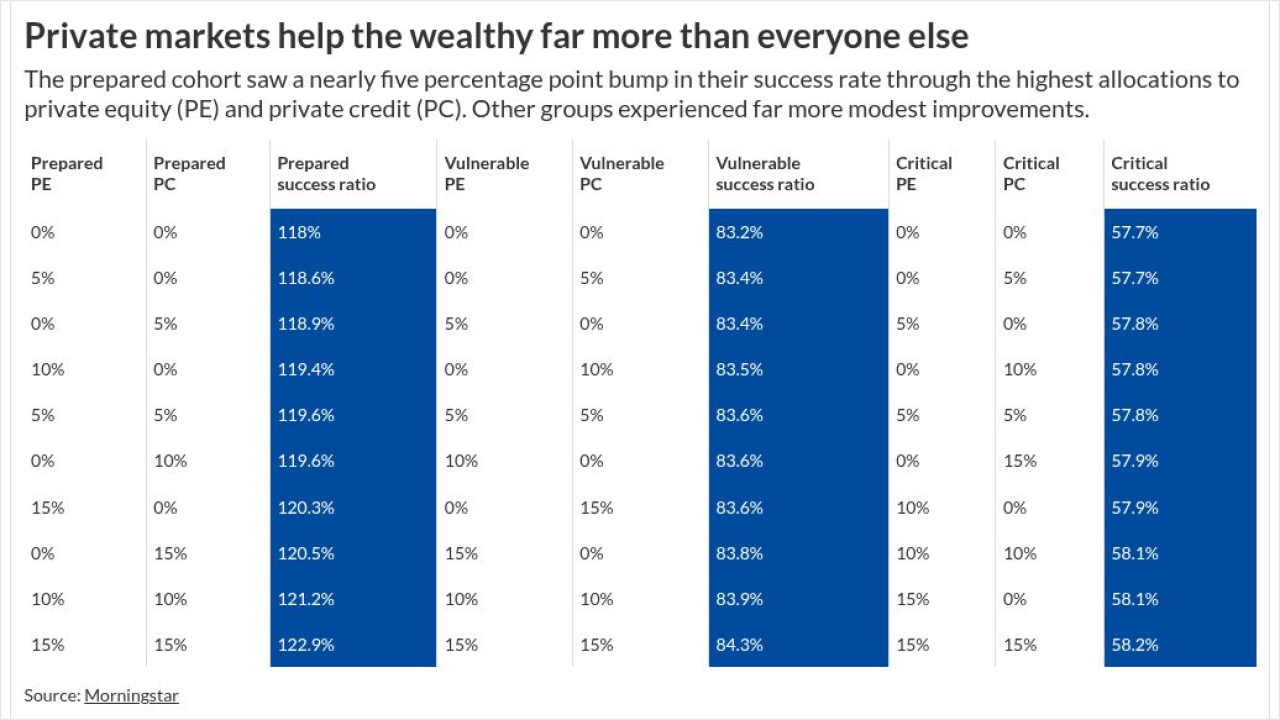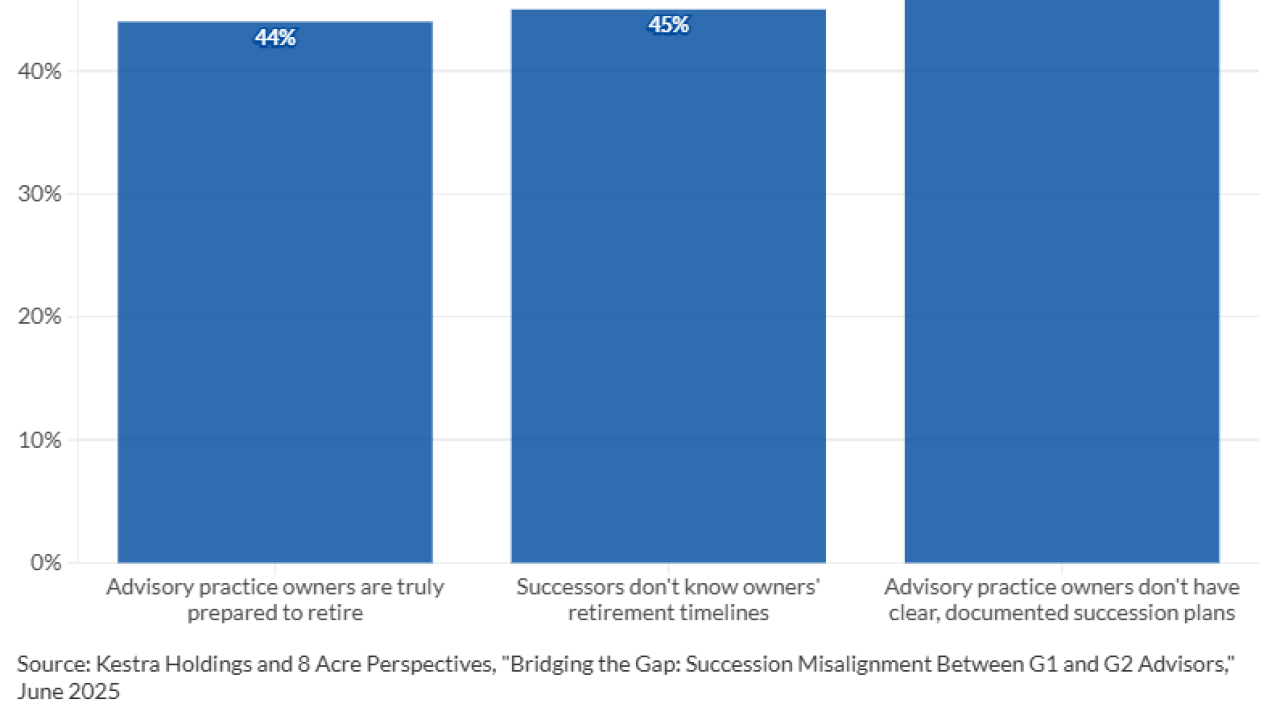Advisor Dennis Stearns of Stearns Financial Group in Greensboro, N.C., is a heavy dabbler in scenario learning the process by which corporate leaders combine possible wild card events as a way to identify future scenarios that nobody is expecting, and then plot out how they would respond.
The classic example is Shell Oil in the 1970s, which used the process to determine in advance how the company might turn to its advantage such strange futures as a major oil supply disruption, an unexpected market glut or as actually happened OPEC nations banding together and demanding dramatically higher market prices for the crude that was being pumped out of their soil. Other oil companies ended up being blindsided by the cartels emergence but Shell executives knew exactly how to respond, and gained significant market share in the ensuing chaos.
So for my recent Insiders Forum conference in Dallas, I wondered: Could Stearns and I use that same technique with a room full of 300 financial planners? There are certainly a lot of unknowns in an advisory practices future a wide variety of possible market outcomes, new regulatory initiatives, another global meltdown or the sudden collapse of nontraded REIT investments.
3 MARKET SCENARIOS
Our scenario learning exercise eventually honed in on three possible futures that are plausible but, for the most part, currently unexpected.
1. The bull comes back. Stearns argues that advisors arent paying nearly enough attention to the possibility that we are in the early stages of an extended bull market run. He points to a long growth curve of corporate profits, dramatic innovations in biotechnology and information science, low inflation and interest rates, and real business efficiency improvements from mobile technology and specialized apps, big data, social media and outsourcing. How should an advisor prepare for the possibility that the bull will just keep on running?
2. Crash and burn. Will the Fed panic at the first sign of a pickup in inflation and raise rates in 50-basis-point increments? Will the Chinese economy experience a setback as its leaders rein in the shadow banking system? Will we see a deflationary spiral in Europe? And who knows what evil brew Wall Street is mixing up to enhance its executive bonus pools? The key question for advisors is: How would you prepare your practice for a stock market free fall of 40% or more?
3. The great muddle. Suppose, as some are predicting, asset classes deliver sideways real returns for more than a decade. This shatters traditional retirement models, and makes frugality the new normal in client lifestyles. At that point, investors would question the value of professional portfolio management. How should advisors respond to a market where returns roughly equal their annual AUM fees?
After a lot of deliberation, the advisors in the room offered a variety of ways to prepare for these disparate futures. They can be grouped into four aspects of a planning practice.
ADJUSTING FEE MODELS
Some of the more thoughtful members of the audience felt like our scenarios presented them with a classic Pascals wager where you have a 50/50 chance of two outcomes, but the outcomes are not symmetrical. If one of them is catastrophic, and the other relatively mild, then your preparations should focus on preventing catastrophe.
In a booming market, advisors sticking with the AUM revenue model will reap more from client portfolios, and be incrementally more profitable than they would have been in a market with more normal returns.
On the other side of the coin, if the markets go into a prolonged bear, or fall into a muddle-through future, AUM revenue will crater along with the value of stocks. At the same time, advisors will experience downward pressure on AUM fees from clients who arent sure they want their advisor to pocket all the returns from their portfolio.
The downside scenarios represent a real threat to the typical advisory firms business model and existence.
How do you prepare? You can win this version of Pascals wager by shifting from AUM fees to annual retainers. This caps the potential revenue upside, but insulates your firm from the worst-case scenario. Its like using some of your retirement money to buy an insurance policy.
FOCUS ON PLANNING SERVICE
This may sound counterintuitive, but the group felt that the raging bull scenario might be the most dangerous for advisory practices. Why? When U.S. equities are outperforming, a prudently diversified portfolio looks stodgy and seems to be costing clients money. Meanwhile, do-it-yourself investors feel like geniuses, and wonder why they would ever need the services of a professional.
A number of participants said that the best way to handle a bull market is to do what many advisors did during the run-up of the late 1990s: Anchor your value proposition on financial planning services, rather than portfolio management.
But heres the interesting part: When advisors analyzed the bearish market scenarios, where low market returns would cause clients to question how much value theyre getting from an advisor, they came to the same conclusion. If your value lies in professional advice, coaching, planning, tax management and helping people get out of their various ruts, then what the markets do becomes less important.
Meanwhile, the best insulation against getting battered by a market downturn or long-term muddle is to lower fixed costs. People talked about outsourcing, adding technology and workflows but perhaps the most tangible recommendation is to create an incentive structure for your staff. You give your employees a lower base salary in return for a higher potential reward when times are good, with a bonus tied to the firms performance.
Heres how that would play out: In a bull market, the staff will get more of the pie than they otherwise would have, but everybody will prosper. In one of the bear market scenarios, youd wind up reducing your firms costs for as long as the downturn lasts avoiding the cash-flow crunch that could lead to bankruptcy.
COMPLIANCE WRINKLES
In addition to the three market scenarios, advisors identified a more likely problem on the horizon expected increases to compliance costs and hassles, no matter what happens between the SEC and FINRA, any new state initiatives, or whether FINRA takes over regulation of RIAs.
Advisors believed that the most practical solution here is consolidation smaller firms merging together to create more scale. Such combinations would make it more affordable to hire compliance professionals to handle the additional paperwork and manage the regulatory oversight.
Does forecast matter?
Our unexpected conclusion was that, to a surprising extent, it may not matter what the future holds. The best way forward for advisory firms seems to be pretty much the same across the spectrum of scenarios: Move toward a retainer revenue model, reinforce and enhance the planning experience, create an incentive compensation structure, make better use of technology and, if you run a small practice, think about the advantages of scale that a merger could provide.
Its as if Shell Oil had gone through a detailed scenario analysis of rising, falling and stable oil prices, and identified a course of action that would benefit the company regardless of what happens to the price of crude.
After the session, I heard many participants say that the exercise gave them a new sense of urgency. Our biggest takeaway was not that the future is going to present us with challenges; we knew that already. Rather, the exercise helped us realize that there are steps you can take to make your practice strong enough to weather whatever storm the future holds in store. And the best time to take those steps is now, before the next storm takes us all by surprise.
Bob Veres, a Financial Planning columnist in San Diego, is publisher of Inside Information, an information service for financial advisors. Follow him on Twitter at
Read more:
Risk Tool Smackdown: FinaMetrica vs. Riskalyze Failed Experiment at the SEC Latest Threat to Financial Advisors





